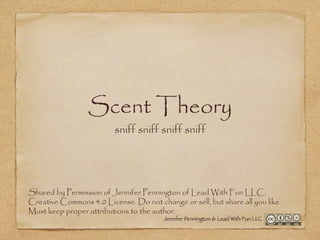LETS Scent Theory 2015
- 1. Scent Theory sniff sniff sniff sniff Shared by Permission of Jennifer Pennington of Lead With Fun LLC. Creative Commons 4.0 License. Do not change or sell, but share all you like. Must keep proper attributions to the author.
- 2. What is Scent? Each human sheds about 40,000 rafts of skin per minute
- 3. What is a Skin Raft? cornflake like skin cell clusters that may also have: bacteria, fungi, parasites sweat, enzymes, hormones personal hygiene products
- 4. Some are lighter than air and travel far in air currents Some are heavier and settle on the ground
- 5. Bacteria that feed on skin rafts are different for every person Dogs can smell the difference
- 6. So how does scent move? Skin rafts are carried in currents of air Pay attention to the movement of air
- 7. Scent and Physics warm air rises (light) cool air sinks (heavy)
- 8. Air is made heavier Cold - it becomes denser Moisture - humidity
- 9. Macro effects general trends a prevailing wind helpful with a subject that has been stationary for a longtime
- 10. Micro effects Your sector down to where you are standing scent can move in different directions within a few feet movement can be different at dogâs nose level
- 11. Diffusion in still air - scent moves evenly in all directions from its source.
- 12. Laminar Flow straight flow of air not interfered with by anything
- 13. Turbulent Airflow laminar air hits an obstacle that creates chaotic behavior building
- 14. Turbulent Air Is the cause of all our scenting nightmares #@*%! $^#*!
- 15. Types of Air Movements knowing different patterns of air movement will help you: correctly analyze potential problems --So you can-- Set your dog up for success
- 18. Coning Plumes movement of scent from subject downwind in the shape of a cone during cloud covered days or nights travels long distances ideal for dogs
- 19. Coning Plumes
- 20. Fumigating Scent in the morning before sunup scents travel down valleys like water subjects on a hill can be detected by dog down below Get dogs out before sunrise
- 21. Fumigating Scent
- 22. Lofting after sun sets ground is cooling but aloft air is warm usually valleys first then other areas later on Work dogs on the high ground in the evening
- 23. Lofting #@*%!
- 24. Fanning Plumes at night in stable air scent holds at the same elevation level dog may alert across a canyon at the same level, but cant find a person Report your alerts
- 25. Fanning Plumes ?
- 26. Pooling Scent collects in an area usually a low area little dispersal of scent by the wind hard for dog to follow to the subject
- 27. Pooling Scent ?
- 28. Eddying Scent circular air forms behind an object prevents scent from traveling along prevailing wind example: eddies form at a line of trees next to an open field
- 29. Eddying Scent ?
- 30. Looping Plumes clear sky or with high clouds at midday, a high convection situation scent rises, cools, falls, heats up, rises, cools, falls, etc. Dog will alert by putting his head up, but will lose the scent.
- 31. Looping Plumes ?
- 32. Chimney Effect air currents move straight up an object alerts may occur nearby -but- makes it impossible for dog to find subject check around tall objects in the area
- 33. Chimney Effect ?
- 34. Thermocline cause by significant temperature and humidity differences in short distances changes in elevation drastic changes in shade and sunny spots creates a wall like barrier of scent
- 35. Thermocline
- 36. What affects scent movement? wind humidity time of day temperature weather terrain vegetation time of year obstacles thermals
- 37. Use what you know in HOW you search A search dog team will prefer to search into the wind Zigzagging into the wind on small areas parallel sweeps across the wind on larger areas often along ridges and downhill with normal daytime updrafts
- 38. See you in the woods! WOO F! This work is licensed under the Creative Commons Attribution- NonCommercial-NoDerivatives 4.0 International License. To view a copy of this license, visit http://creativecommons.org/licenses/by-nc-nd/4.0/.





































